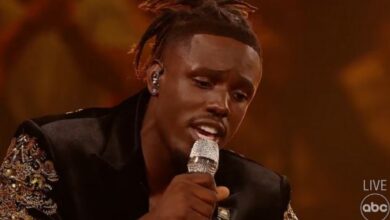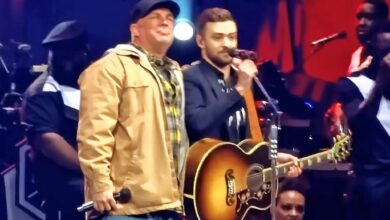From Pop to Rock: The Lasting Influence of ABBA’s “Dancing Queen” Through Our Last Night’s Cover
ABBA’s “Dancing Queen” is one of the most iconic pop songs of all time, originally released in 1976 and quickly becoming a global hit. The song, characterized by its infectious melody, upbeat tempo, and danceable rhythm, captured the essence of the disco era. It was featured on ABBA’s album “Arrival” and soon became a staple at parties and celebrations worldwide, cementing the band’s place in pop music history. Written by band members Benny Andersson and Björn Ulvaeus along with Stig Anderson, the song highlights the joyful yet nostalgic feeling of dancing on a carefree night out, and it remains a timeless classic.
ABBA, formed in Stockholm, Sweden, in 1972, consisted of two couples: Agnetha Fältskog and Björn Ulvaeus, and Anni-Frid Lyngstad (Frida) and Benny Andersson. The band’s name is an acronym derived from the first letters of each member’s name. Throughout the ’70s and early ’80s, ABBA achieved phenomenal success, releasing hits like “Mamma Mia,” “Waterloo,” “Take a Chance on Me,” and, of course, “Dancing Queen.” Their catchy melodies, combined with sophisticated production and harmonies, set them apart from other pop groups of their time. Despite disbanding in 1982, ABBA’s music has continued to influence artists and audiences, with their songs remaining popular across generations.
“Dancing Queen,” in particular, has seen numerous covers over the years, each bringing a unique twist to the classic pop hit. One such cover is by the rock band Our Last Night, known for their energetic rock interpretations of popular songs. Their cover of “Dancing Queen” offers a fresh take on the classic, with heavier instrumentals, powerful vocals, and an energetic arrangement that transforms the original disco feel into a modern rock anthem. Our Last Night’s style preserves the catchy essence of ABBA’s original while adding their distinct rock flair, making it both nostalgic and contemporary for listeners.
Our Last Night is an American post-hardcore band formed in 2004, consisting of Trevor Wentworth, Matt Wentworth, Alex “Woody” Woodrow, and Tim Molloy. The band is known for blending melodic elements with rock and post-hardcore influences, often covering popular songs from different genres and making them their own. Their take on “Dancing Queen” is a testament to their creativity and ability to reimagine classics. By infusing heavy guitar riffs, dynamic drum patterns, and powerful vocals into the cover, Our Last Night manages to pay homage to ABBA’s original while introducing the song to a new audience with a fresh sound.
ABBA’s original “Dancing Queen” has been celebrated for its production quality and lyrical themes that speak to the excitement of youth, love, and the joy of dancing. It topped the charts worldwide, including the United States, where it became ABBA’s only number-one hit on the Billboard Hot 100. The song’s enduring appeal lies in its ability to evoke a sense of freedom and joy, and it is often considered one of the greatest pop songs ever made. The track’s infectious melody, coupled with the harmonious blend of Agnetha’s and Anni-Frid’s vocals, continues to make “Dancing Queen” a fan favorite at weddings, dance parties, and celebratory events.
By covering a song as universally loved as “Dancing Queen,” Our Last Night has contributed to keeping the legacy of ABBA alive, showing that their music transcends genres and generations. Their rock interpretation brings a different energy to the song, focusing on more aggressive instrumentals and a harder edge while still capturing the essence of the original. The cover resonates not only with longtime ABBA fans who enjoy a new take on the classic but also with rock fans who might be discovering the song for the first time through Our Last Night’s rendition.
The success of “Dancing Queen” and its numerous covers highlight ABBA’s broad influence on the music industry. Despite the band’s breakup, their music continues to inspire artists across genres, and they have experienced a resurgence in popularity over the years, thanks in part to musicals like “Mamma Mia!” and the accompanying films that feature their music. This enduring appeal shows that ABBA’s ability to create universally relatable music, with melodies that stay in your head and lyrics that speak to the joy of living, has ensured their songs remain relevant and beloved to this day.
ABBA’s songwriting prowess, particularly in “Dancing Queen,” showcases their ability to blend catchy pop hooks with meaningful lyrics. The song narrates the experience of a young woman enjoying her night out, embodying themes of freedom, joy, and the ephemeral nature of youth. This combination of relatable storytelling and memorable melodies is a hallmark of ABBA’s music, contributing to their lasting legacy in the pop music canon.
The instrumentation in “Dancing Queen” is another key factor in its timeless appeal. The song features a rich arrangement of strings, piano, and rhythmic percussion, creating a lush soundscape that enhances its uplifting message. The production quality, spearheaded by Michael B. Tretow, who worked closely with ABBA, ensures that each element of the song is polished and contributes to its overall grandeur. This meticulous attention to detail in production set ABBA apart from many of their contemporaries and helped them achieve a distinctive sound.
ABBA’s influence extends beyond their music; their image and fashion also left a significant mark on pop culture. The band’s flamboyant costumes, colorful outfits, and distinctive hairstyles became iconic, complementing their vibrant and upbeat music. This visual aspect of ABBA’s presentation played a crucial role in their global appeal, making them not only musical icons but also fashion trendsetters of their time.
In recent years, ABBA has seen a resurgence in popularity, particularly with the release of the “Mamma Mia!” musical and films, which introduced their music to a new generation. This revival has brought renewed attention to classics like “Dancing Queen,” ensuring that ABBA’s legacy continues to thrive. Additionally, the band’s music has found new life on streaming platforms, allowing their songs to reach even wider audiences and maintain their relevance in the modern music landscape.
The legacy of “Dancing Queen” is also evident in its recognition by various music institutions. The song has been inducted into the Grammy Hall of Fame and is frequently cited in lists of the greatest pop songs of all time. Its influence can be seen in the works of contemporary artists who draw inspiration from ABBA’s songwriting and production techniques, further cementing the song’s place in music history.
Moreover, “Dancing Queen” has played a significant role in shaping the genre of pop music. Its blend of disco rhythms, pop melodies, and sophisticated harmonies set a standard for future pop productions. The song’s ability to balance commercial appeal with artistic integrity serves as a blueprint for pop artists aiming to create music that is both commercially successful and artistically respected.
ABBA’s “Dancing Queen” remains a testament to the band’s exceptional talent and enduring appeal. Its ability to evoke joy, nostalgia, and a sense of timelessness ensures that it will continue to be celebrated and enjoyed by generations to come. Whether through original performances or creative covers like those by Our Last Night, “Dancing Queen” stands as a shining example of pop music’s power to transcend time and connect with people across different eras and cultures.



